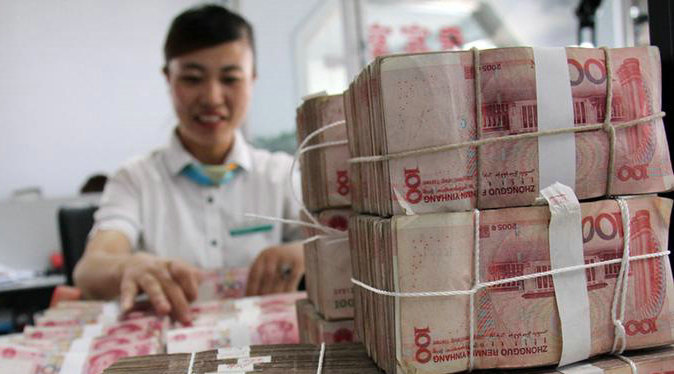By Ji Peijuan from People’s Daily

China now still holds the largest foreign exchange reserve stockpile in the world, much higher than the runner-up, Zhou Xiaochuan, the governor of the People’s Bank of China said on Friday, but stressed that there is no need for China to overreact to the large stockpile when making policies.
He said so when addressing the outside concerns at a press conference on the sidelines of the ongoing annual legislative session.
The latest data released by China’s State Administration of Foreign Exchange (SAFE) on Tuesday showed that the country's outstanding forex reserves stood at 3.0051 trillion US dollars by the end of February, up 6.9 billion dollars than a month earlier. The slight rise also put an end to a seven-month decline.
“China does not want that much forex reserve,” the governor stressed, adding that these reserves also included some unnecessary hot money.
He explained that China’s forex reserve saw a rapid run-up since 2002, and some international frictions were resulted because of the trend then.
After the global financial crisis broke out, capital flow from developed countries adopting quantitative easing measures to emerging markets had surged significantly, he said.
The International Monetary Fund (IMF) estimated the liquidity created by developed countries at about 4.2 trillion dollars, the governor introduced, adding that at least one-third of the money flowed to China.
With the economic recovery of some developed countries, these capital influx with less stability will flow back to them, he noted.
“So the dropping trend in China’s foreign exchange reserve is a normal phenomenon,” the governor concluded.
Yi Gang, deputy governor of the People's Bank of China, said that the RMB is now among the first-tier teams of international currencies after it was included into IMF’s Special Drawing Right (SDR) currency basket last year.
“Amid such backdrop, we can consider further on how to optimize the forex level,” he added.
Pan Gongsheng, another deputy governor of the People’s Bank of China, told the same press conference that some structural changes have occurred in the asset holders, but towards a better direction.
“Several years ago, about 70 percent to 80 percent of the reserves were held by governmental bodies, while by the end of last year, about 50 percent of them were maintained by governmental bodies and another 50 percent by market entities,” said Pan, also head of SAFE.
“The medium-high speed growth maintained by Chinese economy provides a stable basis for the future forex market,” he underlined.
Tommy Xie, an economist at Singapore-based Oversea-Chinese Banking Corp., is bullish on an overall stable RMB exchange rate.
He said in an interview with the People’s Daily that if Fed interest rate hike in March comes true, it will pose bigger depreciation pressure on RMB in a short run.
But the analyst underlined at the same time that the confidence brought by steady economy and unexpected rise in forex reserves will significantly ease the capital outflow pressure, and the devaluation pressure will thus be under control.
He said so when addressing the outside concerns at a press conference on the sidelines of the ongoing annual legislative session.
The latest data released by China’s State Administration of Foreign Exchange (SAFE) on Tuesday showed that the country's outstanding forex reserves stood at 3.0051 trillion US dollars by the end of February, up 6.9 billion dollars than a month earlier. The slight rise also put an end to a seven-month decline.
“China does not want that much forex reserve,” the governor stressed, adding that these reserves also included some unnecessary hot money.
He explained that China’s forex reserve saw a rapid run-up since 2002, and some international frictions were resulted because of the trend then.
After the global financial crisis broke out, capital flow from developed countries adopting quantitative easing measures to emerging markets had surged significantly, he said.
The International Monetary Fund (IMF) estimated the liquidity created by developed countries at about 4.2 trillion dollars, the governor introduced, adding that at least one-third of the money flowed to China.
With the economic recovery of some developed countries, these capital influx with less stability will flow back to them, he noted.
“So the dropping trend in China’s foreign exchange reserve is a normal phenomenon,” the governor concluded.
Yi Gang, deputy governor of the People's Bank of China, said that the RMB is now among the first-tier teams of international currencies after it was included into IMF’s Special Drawing Right (SDR) currency basket last year.
“Amid such backdrop, we can consider further on how to optimize the forex level,” he added.
Pan Gongsheng, another deputy governor of the People’s Bank of China, told the same press conference that some structural changes have occurred in the asset holders, but towards a better direction.
“Several years ago, about 70 percent to 80 percent of the reserves were held by governmental bodies, while by the end of last year, about 50 percent of them were maintained by governmental bodies and another 50 percent by market entities,” said Pan, also head of SAFE.
“The medium-high speed growth maintained by Chinese economy provides a stable basis for the future forex market,” he underlined.
Tommy Xie, an economist at Singapore-based Oversea-Chinese Banking Corp., is bullish on an overall stable RMB exchange rate.
He said in an interview with the People’s Daily that if Fed interest rate hike in March comes true, it will pose bigger depreciation pressure on RMB in a short run.
But the analyst underlined at the same time that the confidence brought by steady economy and unexpected rise in forex reserves will significantly ease the capital outflow pressure, and the devaluation pressure will thus be under control.
 Menu
Menu
 Central bank governor urges not to overreact to China’s forex stockpile
Central bank governor urges not to overreact to China’s forex stockpile
















